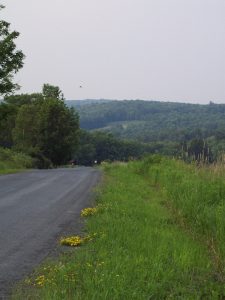
Beautiful, isn’t it?
Okay, some of these kinds of forward-by-email jokes are kind of lame, but this one is spot-on — it HAD to be written by someone who actually knows rural Upstate.
Some of them really zinged me — just spot on: 4, 10, 22, 24, 36, 43, 45, 51, 61, 64.
And of course, 30. Because even after years of being gentrified by Rochester ‘burb living, I am proud of having Chenango County roots — I have a better grasp on reality for having grown up there, if I do say so myself :-)
[P.S.: a LOT of my novels are set in upstate New York! The French Emerald (free serial to read online!) starts in Rochester but zigzags all over the state–and part of the plot includes a Revolutionary-era Upstate NY mystery. Loose Dogs is set in Rochester. Dark Chemistry features a “fish out of water” dilemma when a Southern California girl gets stuck in a little Upstate NY town and guess what–ends up liking it ;) — please check them out if you enjoy novels!]
Enjoy!
1. Your idea of a traffic jam is 10 cars waiting to pass a tractor on the highway
2. “Vacation” means going to Syracuse for the weekend
3. You measure distance in hours
4. You know several people who have hit deer more than once
5. You often switch from “heat” to “A/C” in the same day
6. You stay in your house most of the summer because you aren’t used to the heat
7. You drive at 55 mph through 10 feet of snow during a raging blizzard without flinching
8. You see people wearing hunting clothes at social events
9. You install security lights on your house and garage but leave both unlocked
10. One of your neighbors constantly has bonfires
11. You carry jumper cables in your car and your girlfriend knows how to use them
12. There are 7 empty cars running in the parking lot at the supermarket at any given time
13. Your idea of a huge party is one with lots of cheap beer and some people you go to school with
14. Driving is better in the winter because the potholes are filled in with snow
15. You think sexy lingerie is silk pajamas from wal-mart
16. You know 4 seasons: almost winter, winter, cold, construction
17. It takes you 2 hours to go to the store for one item even when you’re in a rush because you have to stop and talk to everyone in town
18. At least 6 people that you see a day have beards and stains on the front of their shirt
19. Cows are just part of the scenery
20. You or someone you know has a car that sounds like a big truck and can barely make it 20 miles yet no one says anything about it.
21. At least fives times in your normal travel day you will pass or be passed by a beat-up, old ass car that has had an attempted pimping out, such as a brand new oversized spoiler on a rust covered trunk, spinning HUBCABS, or everyones favorite, the performance exhaust on a car running on barely three cylinders.
22. You know that the phrase, “Goin up ta,” applies to going north, south, east, or west, up or down in elevation, and pretty much any other way you can travel.
23. The smell of freshly spread cow manure doesn’t bother you.
24. Its perfectly normal for your life’s aspirations to be working for the county.
25. Getting “dressed up” means tucking your shirt into your jeans and putting on clean work boots.
26. Holloween costumes are always designed around a snowsuit and winter boots.
27. You appreciate the delicacy known as Croghan Bologna, and serve it at all social gatherings.
28. On the same platter as the Croghan Bologna is a selection of flavored cheese curd, which you also love.
29. You know damn well that the verizon guy didn’t walk through your town going, “can you hear me now” because reception is, at best, limited.
30. Your proud of your redneck-ness and where your from.
31. You can name everyone you graduated with.
32. You know what 4-H is.
33. You ever went to a party that was held about 20 miles down a deserted dirt road.
34. You used to drag “main.”
35. You said the ‘F’ word and your parents knew within an hour.
36. You schedule parties around the schedule of different police officers since you know which ones would bust you.
37. You never went or thought about going cow-tipping.
38. School gets canceled for a sports team going to State
39. You could never buy cigarettes cause all the store clerks knew how old you were.
40. When you did find someone old enough to buy smokes for you, you had to drive down country backroads to smoke them.
41. You never missed a Homecoming parade.
42. You still go home for Homecoming.
43. It was cool to date someone from a neighboring town.
44. You had a senior skip day.
45. The whole school went to the same party after graduation.
46. You can’t help but date a friend’s ex.
47. Your car is always filthy from the dirt roads.
48. You think that kids who ride skateboards are weird.
49. The town next to you is considered “trashy” or “snotty” when it is just like your town.
50. Getting paid minimum wage is considered a raise.
51. You refer to anyone with a house newer than 1980 as the “rich people.”
52. The people in the big city dress funny then you pick up on the cool new trend two years later.
53. You bragged to your friends because you got pipes on your truck for your birthday.
54. On Fridays, anyone you want to find can be found at Main Street or the Dairy Queen.
55. Weekend excitement involves a trip to RiteAid.
56. Even the ugly people enter beauty contests.
57. You decide to walk for exercise and 5 people pull over and ask you if you need a ride.
58. Your teachers call you by your older sibling’s name.
59. The closest “cool stores” are at least 45 miles away.
60. The local phone book has only one yellow page.
61. You leave your jacket on the back of the chair in the
cafe, and when you go back the next day, it’s still there, on the same chair.
62. You don’t signal turns because everyone knows where you’re going, anyway.
63. You call a wrong number and they supply you with the correct one.
64. You have to name six surrounding towns to explain to
people where you’re from.
65. Driving to the party on a four wheeler is quite normal.
66. The town population increases by one-third when the universities go on break.
67. When somebody says “Thats billy fucillo HUGE” you know exactly what they are talking about
68. You laugh your head off reading this because you know it’s true and then forward it to everyone in your address book, which is actually half your town.




 My daughter & nephew found this cicada on my parents’ pool deck this morning. It was sluggish from the cold so I was able to hold it for quite awhile to photograph it, until it got warm enough from the sun to fly off.
My daughter & nephew found this cicada on my parents’ pool deck this morning. It was sluggish from the cold so I was able to hold it for quite awhile to photograph it, until it got warm enough from the sun to fly off.
